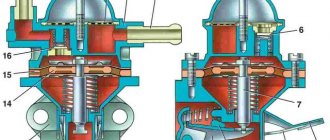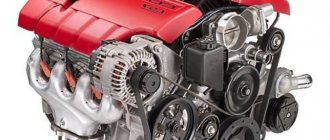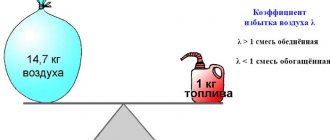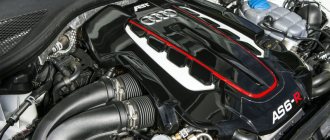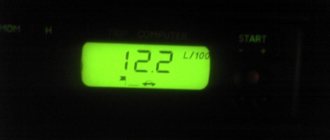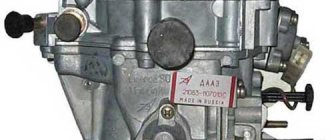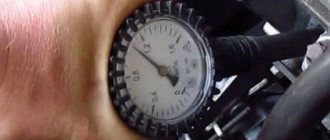The fuel supply system of a gasoline engine ⭐ is designed to accommodate and purify fuel, as well as prepare a combustible mixture of a certain composition and supply it to the cylinders in the required quantity in accordance with the operating mode of the engine (except for engines with direct injection, the power system of which ensures the supply of gasoline to the chamber combustion in the required quantity and under sufficient pressure).
Gasoline , like diesel fuel, is a product of petroleum distillation and consists of various hydrocarbons. The number of carbon atoms included in gasoline molecules is 5 - 12. Unlike diesel engines, in gasoline engines the fuel should not be intensively oxidized during the compression process, as this can lead to detonation (explosion), which will negatively affect performance, efficiency and power engine. The knock resistance of gasoline is measured by its octane number. The larger it is, the higher the fuel’s detonation resistance and the permissible compression ratio. Modern gasoline has an octane number of 72–98. In addition to anti-knock resistance, gasoline must also have low corrosive activity, low toxicity and stability.
The search (based on environmental considerations) for alternatives to gasoline as the main fuel for internal combustion engines led to the creation of ethanol fuel, consisting mainly of ethyl alcohol, which can be obtained from plant biomass. There is a distinction between pure ethanol (international designation E100), containing exclusively ethyl alcohol; and a mixture of ethanol and gasoline (most often 85% ethanol with 15% gasoline; designation E85). In terms of its properties, ethanol fuel is close to high-octane gasoline and even surpasses it in terms of octane number (more than 100) and calorific value. Therefore, this type of fuel can be successfully used instead of gasoline. The only drawback of pure ethanol is its high corrosiveness, which requires additional protection against corrosion of fuel equipment.
The units and components of the fuel supply system of a gasoline engine are subject to high requirements, the main of which are:
- tightness
- fuel dosing accuracy
- reliability
- ease of maintenance
Currently, there are two main methods for preparing a combustible mixture. The first of them is associated with the use of a special device - a carburetor, in which air is mixed with gasoline in a certain proportion. The second method is based on forced injection of gasoline into the engine intake manifold through special nozzles (injectors). Such engines are often called injection engines.
Regardless of the method of preparing a combustible mixture, its main indicator is the ratio between the mass of fuel and air. When ignited, the mixture should burn very quickly and completely. This can be achieved only with good mixing of air and gasoline vapor in a certain proportion. The quality of the combustible mixture is characterized by the excess air coefficient a, which is the ratio of the actual mass of air per 1 kg of fuel in a given mixture to the theoretically necessary one, ensuring complete combustion of 1 kg of fuel. If there are 14.8 kg of air per 1 kg of fuel, then such a mixture is called normal (a = 1). If there is slightly more air (up to 17.0 kg), the mixture is lean, and a = 1.10... 1.15. When there is more than 18 kg of air and a > 1.2, the mixture is called lean. Reducing the proportion of air in the mixture (or increasing the proportion of fuel) is called enrichment. When a = 0.85... 0.90 the mixture is enriched, and when a < 0.85 it is rich.
When a mixture of normal composition enters the engine cylinders, it operates stably with average power and efficiency. When operating on a lean mixture, engine power is slightly reduced, but its efficiency is noticeably increased. On a lean mixture, the engine operates unstably, its power drops, and specific fuel consumption increases, so excessive leaning of the mixture is undesirable. When a rich mixture enters the cylinders, the engine develops the greatest power, but fuel consumption also increases. When running on a rich mixture, gasoline burns incompletely, which leads to a decrease in engine power, increased fuel consumption and the appearance of soot in the exhaust tract.
About the design features of diesel engines in comparison with gasoline engines
Both diesel and gasoline engines are internal combustion engines. In a global sense, in its design, a diesel engine is no different from a gasoline engine: both have cylinders, pistons and connecting rods. However, in diesel engines the compression ratio is much higher (19-24 units, while in gasoline engines it is 9-11). Therefore, all parts and valves are significantly reinforced (to withstand much higher loads). Therefore, the weight and dimensions of a diesel engine are much more impressive than a gasoline engine.
The main difference lies in the methods of forming the fuel/air mixture, its ignition and combustion. In gasoline engines, a mixture of fuel and air is formed in the intake system, and it is ignited by a spark from the spark plug. In diesel engines, fuel and air are supplied to the working cavities of the cylinders separately. First the air. It heats up to seven to eight hundred degrees and contracts. When fuel is then injected into the combustion chamber under high pressure, it spontaneously ignites, almost instantly.
Thus, no spark is required. And the glow plugs, which are installed in the cylindrical head, are heating elements, like a soldering iron, and they are designed to quickly heat the air in the combustion chamber while the engine has not yet warmed up. This is called a pre-heating system.
When the ignition is turned on, the glow plugs heat up to 800-900 degrees in a few moments, warming up the air and ensuring the process of self-ignition. A warning lamp provides the driver with signals about the operation of this system. The power supply is removed from the spark plugs automatically, 15-20 seconds after starting a cold engine, when its stable and stable operation is already fully ensured. The decisive role in ensuring such engine performance indicators belongs to its fuel system, the design of which will be discussed.
Fuel level sensor
It is located on the pump module. By design, the fuel level sensor is a small system consisting of a float and a variable resistance mechanism with a nylon contact. Depending on the amount of contents in the fuel tank, the resistance of the element changes, which is indicated by an arrow on the instrument panel in the cabin.
It should be noted that the gasoline sensor is not negatively affected by low-quality fuel additives and does not break down due to frequent changes in temperature and pressure inside the tank.
The principle and general scheme of operation of the fuel system
The operating sequence of the diesel engine fuel system is as follows. Diesel fuel is pumped from the fuel tank using a fuel priming pump (gear or pump type), and after filtration it is supplied by a high pressure fuel pump (HPFP) to the injectors. After being pumped from the tank, fuel first passes through a coarse filter, getting rid of large inclusions. Further, directly in front of the high pressure fuel pump - through a fine filter. In conjunction with the fuel injection pump, nozzles work through which diesel fuel is sprayed and injected into the cylinders.
The diagram of the fuel system of a diesel engine engine can not be conditionally, but quite clearly divided into two compartments: high pressure and low. In the low-pressure section, preliminary preparation and filtration of the fuel mixture are carried out before sending it to the high-pressure section. The high-pressure compartment, in turn, completes the mixture and transfers it to the working chamber.
Node device
Oddly enough, the layout of the diesel fuel system is very similar to its gasoline counterparts. The only difference is the injection system. But more on that a little later, but for now let’s look at the design of this unit.
So, the fuel system diagram assumes the presence of the following structural elements:
- Gas tank. This element can be made of thin sheet steel or very dense polypropylene. On cars and SUVs, the gas tank is installed on the bottom. On trucks, in particular truck tractors, it is mounted on special supports between the rear and front axles (on the left or right side). The fuel tank has a valve that prevents fuel from leaking when the vehicle rolls over.
Filler cap. This part has a special thread that allows air to enter when unscrewing it. And to make it convenient for the driver to unscrew the cover, it has a special ratchet mechanism. This element also contains a safety valve, which, if the car gets into an accident, relieves the pressure inside the tank. By the way, on modern cars with Euro-2 or higher exhaust standards, fuel vapors are not allowed to enter the atmosphere. Therefore, to catch them, a special carbon adsorber is installed in the system.- Fuel pump. This element is electrically driven and is located inside the tank. The pump is controlled by an electronic control unit. The part is activated using a special relay. When the driver turns on the ignition, it works for some time (no more than 4-5 seconds), thereby providing the necessary pressure in the system to start the engine. It is also worth noting that the pump is cooled by gasoline. Therefore, working with an empty tank can damage it.
- Fuel filter. Often a car is equipped with two types of these elements. This is a mechanism for fine and coarse fuel purification. The strainer is mounted on the fuel pump housing. The essence of its work is to trap contaminants that can enter the engine and form excess carbon deposits. Also, a working filter significantly increases the service life of the pump, preventing its frequent contamination. The fine cleaning mechanism is located on the underbody, in front of the rear suspension of the car. This type of filter is based on a paper element that is capable of trapping small particles of dirt, resins and deposits that can damage the fuel system.
The main function of the fuel system, description of its operation
The purpose of the diesel engine fuel system is to supply a precisely measured volume of diesel fuel into the cylinders, at a specific point in time and under a certain pressure. Therefore, due to the need to ensure a constantly high pressure, as well as due to high requirements for accuracy of operation, the fuel system of a diesel engine will be more complex in design than that of a gasoline engine, and is quite expensive.
Now let’s try to imagine the uninterrupted operation of the fuel system in a step-by-step mode, and for this we will analyze its individual components in order. So, the fuel tank serves to accommodate diesel fuel and ensure its uninterrupted supply to the system. This function is performed by pipelines. First, the fuel priming pump sucks fuel from the tank and supplies it through filters to the low-pressure distribution line. At the same time, a stable pressure of three atmospheres is maintained in the system. The fuel is filtered twice, passing through coarse and fine filters.
The task of fuel filters is to control the purity of the fuel and rid it of possible foreign impurities - particles of dirt, water, grains of sand. Gone are the days when diesel engines were very unpretentious in terms of fuel quality. Modern diesel engines require very clean diesel fuel to maintain decent performance. Clean fuel is now one of the main and indispensable conditions for efficient engine operation. Fuel is supplied only if there is no air in the system.
After filtration, the diesel fuel enters the high pressure line. This part of the fuel system ensures that the required amount of fuel is supplied and injected into the engine cylinders at certain moments. The high-pressure fuel pump, in accordance with the operating order of the cylinders, supplies diesel fuel to the injectors through high-pressure fuel lines.
Injectors located in the cylinder heads inject and spray fuel into the combustion chambers of the engine. Since the fuel priming pump constantly supplies the high-pressure fuel pump with fuel “with a reserve”, that is, slightly more than needed, its excess, and with it the air that has entered the system, is discharged back into the tank through special drainage pipelines.
To ensure synchronous fuel injection, a special fuel frame is installed, to which the injectors are connected. They are located in the intake pipe with their heads and spray fuel immediately at the moment of its supply.
The injection pump creates the pressure required for injection, and the fuel is distributed to all cylinders of the engine. The amount of fuel injected, and with it the power mode of the engine, is varied by pressing the accelerator pedal. In modern diesel engines, simply pressing the gas pedal does not increase the volume of supplied fuel, but only changes the program according to which the regulators operate.
Yes, by pressing the pedal, the driver or machine operator no longer increases the direct fuel supply, as was the case in carburetor engines of past years. But it only changes the operating programs of the regulators, which themselves vary the volume of simultaneous fuel supply, according to strictly defined dependencies on the speed, boost pressure, position of the regulator lever, etc.
Injector features
The fuel system diagram (including Mercedes E200) of the injection type has a fundamental difference from the carburetor analogue:
- Firstly, fuel from the tank in it is supplied to a ramp to which spray nozzles are connected.
- Secondly, air is supplied to the engine combustion chamber through a special throttle assembly.
- Thirdly, the level of pressure created by the pump in the system is many times greater than that created by the carburetor mechanism. This phenomenon is explained by the need to ensure rapid injection of fuel by the nozzle into the combustion chamber.
But this is not the only difference between a fuel injection system and a carburetor. The Chevrolet Niva (its fuel diagram is shown in the photo below), like other modern cars, has at its disposal so-called “electronic brains,” that is, an ECU. The latter is responsible for collecting and processing information from all existing sensors in the car.
So, the ECU also controls gasoline injection. Depending on the operating mode, the electronics independently determine which mixture needs to be fed into the cylinder - lean or rich. But this is not the only difference between the injection-type fuel system (Ford Transit CDi among others). It can have a different number of nozzles. We will talk about this in the next section.
The main components of the diesel engine fuel system
So, in addition to the fuel tank and main fuel lines, with which everything is more or less clear, the main components of the fuel system of a diesel engine are: a fuel priming pump, coarse and fine fuel filters, a high-pressure fuel pump (HPF) and injectors.
Fuel lift pump
The design of a diesel fuel booster pump is quite simple. It consists of two gears that are in constant mesh. When the rotation process occurs, the teeth of these gears act as blades, creating and maintaining a flow of fuel towards the injection pump. The main operating element of the booster pump, which directly pumps fuel, is the piston. As already noted, the capacity of the fuel priming pump is designed to exceed the capacity of the high-pressure pump, which is why special fuel lines are equipped to drain the excess back into the fuel tank.
High pressure fuel pump
The injection pump is designed to supply fuel to the injectors under pressure, in accordance with a strictly defined program, depending on the specified engine operating modes and the driver’s control actions. At its core, a modern all-mode fuel injection pump combines the functions of a complex automatic engine control system and, at the same time, a main actuator that responds to the driver’s commands.
Thanks to the introduction into production of high-pressure fuel pumps with electronic control systems, as well as 2-stage fuel injection and optimization of the combustion process, it was possible to achieve fairly stable operation of a diesel engine with an undivided combustion chamber at speeds up to 4500 per minute, optimize its efficiency, reduce noise and vibrations.
Next: along the entire length of the pump, in its internal cavity, there is a rotating shaft equipped with special cams. This injection pump shaft receives rotational energy from the engine camshaft. When moving, its cams act on the pushers, which, in turn, stimulate the pumping work of the piston-plunger. As it moves upward, this plunger creates high fuel pressure inside the cylinder. The force of this pressure pushes out the fuel, which is directed along the fuel line to the injectors.
For comparison: in the section of the low-pressure fuel system, where the fuel priming pump drives diesel fuel through the filters to the injection pump, the pressure is 3 atmospheres. And the high-pressure fuel pump pushes fuel to the injectors with a pressure force of up to 2000 atmospheres! This is necessary in order to ensure high-quality injection and atomization of the fuel mixture into the combustion chambers of the engine cylinders.
Inside the housing, or sleeve, of the high-pressure fuel pump there is a plunger, otherwise a special piston with a diameter significantly smaller than its length. This is called a plunger pair. Its parts are ground to each other in such a way that the gap does not exceed 4 microns.
Since the operation of a diesel engine in different modes and at different speeds requires, accordingly, different amounts of fuel, the design of the plunger was slightly changed: a special spiral groove was “run” along its surface, which allows you to change the amount of the active stroke using the plunger rotation mechanism.
This was done so that the plunger could not only pump fuel under pressure towards the injectors, but also regulate the quantity and volume of this supply. For this purpose, there is a movable part of the plunger, which, depending on changes in parameters, can open or close the grooves inside it. This moving part is connected to the gas pedal in the driver’s cab.
Depending on the angle of rotation of the plunger, the corresponding degree of opening of the fuel passage channels and its direct amount supplied to the injectors are set.
Injectors
Another important element of the fuel system of a diesel engine is the injectors on each of its cylinders. They, together with the injection pump, ensure the supply of a strictly dosed amount of fuel to the combustion chambers. Adjustments to the opening pressure of the injector form the operating pressure in the fuel system, and the types of atomizers determine the shape of the fuel spray, which is important for activating the processes of self-ignition and combustion. Modern diesel engines usually use two types of injectors: with a font or with a multi-hole distributor.
The injectors on the engine have to work in very difficult conditions: the nozzle needle makes reciprocating/forwarding movements with a frequency half as fast as the engine speed, and at the same time the nozzle is in direct contact with the combustion chamber all the time. Therefore, the nozzle nozzle is made of special, highly heat-resistant alloys, is made with extreme precision and is a precision element.
The injector distributor performs the function of uniformly supplying fuel to the combustion chambers and igniting it most efficiently. The finer the fuel mixture is sprayed, the more stable, in general, the operation of the power unit is. An equally important factor is the uniformity of fuel spraying in all possible directions. Modern injectors are made with numerous tiny holes, just so that the fuel mixture is sprayed in all directions and evenly.
In addition, the operation of the injectors supports the following processes, which are directly related to the efficient operation of the engine:
- Ensuring high pressure and temperature in combustion chambers;
- Mixing diesel fuel with air in the optimal volume;
- Correspondence of the injection advance angle to the engine crankshaft rotation speed.
Injectors are available with mechanical or electromagnetic control. In conventional injectors, the opening of the nozzle hole is related to the pressure that is available in the fuel line at that time. The nozzle hole is closed by a needle connected to a special piston at the top of the nozzle. While there is no pressure, the needle blocks the fuel outlet through the nozzle hole. When fuel enters under pressure, the piston moves up and pulls the needle along with it. The hole opens and spraying begins.
Modern diesel engines use injectors with an electromagnetic control system. Their operation is no longer regulated according to a mechanical principle, but with the help of electromagnetic pulses coming from the control unit. Each of the injectors is equipped with a solenoid valve that opens or closes fuel spray.
These electromagnetic elements of the injectors receive signals from the electronic control unit (ECU), which, in accordance with information from a number of sensors, issues one or another command to set the desired degree of atomization.
Fuel injection scheme for injection cars
Currently, there are two types of injection systems:
- Single injection.
- With distributed injection.
In the first case, fuel is supplied to all cylinders using one nozzle. At the moment, single injection systems are almost never used on modern cars, which cannot be said about cars with distributed injection. The peculiarity of such injectors is that each cylinder has its own individual nozzle. This installation scheme is very reliable, and therefore all modern automakers use it.
A few words about the Common Rail system
Speaking about the fuel system of modern diesel engines, one cannot fail to mention such a modification as the “CommonRail Battery Fuel System” (“Common Frame”, or “Common Highway” in translation from English). It shows very good indicators of economy and efficiency, and is deservedly gaining more and more popularity. First of all, on diesel engines of commercial vehicles, of course.
It also uses a fuel injection pump that supplies fuel to the pressure line, which plays the role of a pressure accumulator. The electronic control unit regulates the pump performance to maintain the required pressure in the line as fuel is consumed.
In CommonRail, electronically controlled electro-hydraulic injectors with electromagnetic or piezoelectric actuators of control valves inject calibrated doses of diesel fuel under high pressure into the working cavities of the cylinders.
A computer fuel supply control system allows it to be injected into the combustion chambers of the cylinders in the most accurately metered doses. First, a microscopic portion, only about a milligram, is injected, which, by its combustion, heats up the temperature in the chamber, and is followed by the main “charge”. As a result, diesel engines equipped with the Common Rail system show better efficiency (up to 20 percent). The share of new diesel engines equipped with the CommonRail system is growing steadily from year to year.
Injectors
This part is of particular importance for the car, since the quality of combustion of the fuel-air mixture, fuel consumption and power of the vehicle depend on its condition. The injector is a small mechanism with a solenoid valve. The latter is controlled by an ECU. When the control unit commands power to the injector winding, the closed ball valve opens and fuel passes through the plate into the injector nozzles. By the way, there are holes on the plate used to adjust fuel consumption. Fuel is injected by a nozzle into the channel of several intake valves. As a result, it evaporates before entering the combustion chamber of the engine.
Additives and their use
In conclusion, I would like to talk a little about additives for flushing injectors, in which systems should they be used and in which should they not be used?
Firstly , the use of any additives for cleaning injectors, whether distributed or direct injection, must be done at your own peril and risk. There are a lot of fakes, a lot of deception, and you can “crash” the injector even worse than cleaning it.
Secondly , distributed injection is less susceptible to an aggressive environment, because it is located in the intake manifold, there are no high temperatures, and therefore such injectors can run for 70 - 80,000 without cleaning. You can add fuel additives to them, which (if they work) can easily “wash away” the deposits on them. THIS IS REASONED HERE!
Thirdly , direct injection, as I already wrote - that the injectors are in an aggressive environment! All sorts of deposits are simply baked on them (which settles both in the cylinders and on the spark plugs). It is difficult to wash it off, and with the use of some additives - so it is advisable to remove them and clean them at a service station, on a stand, and let them demonstrate their performance to you. YES it is more expensive, but I told you that such a fuel supply system is more expensive to operate. I WOULD NOT USE ADDITIVES TO CLEAN THEM.
That’s it, now there’s a detailed video version of the article, for those who didn’t understand, I tried to make it simple.
Read our AUTOBLOG, there will be many more useful articles and videos.
Similar news
- Engine without valve springs. Really a revolution in the engine industry...
- Efficiency of an internal combustion engine. Approximately how much is...
- Scratches on the car body
Add a comment Cancel reply
Power System Options
The main types of fuel for internal combustion engines are gasoline and diesel fuel (“diesel fuel”). Gas (methane) also belongs to the types of modern fuel, but, despite its widespread use, it has not yet become relevant. The type of fuel is one of the criteria for classifying internal combustion engine power systems.
In this regard, power units are distinguished:
- gasoline;
- diesel;
- based on gaseous fuel.
But the most recognized among experts is the typology of engine power systems based on the method of fuel supply and preparation of the fuel-air mixture. Following this classification principle, we distinguish, firstly, the power supply system of a carburetor engine, and secondly, the power supply system with fuel injection (or an injection engine).
Carburetor
The carburetor system is based on the operation of a technically complex device - a carburetor. A carburetor is a device that prepares a mixture of fuel and air in the required proportions. Despite the variety of types, in automotive practice the most widely used is the float suction carburetor, the circuit diagram of which includes:
- float chamber and float;
- atomizer, diffuser and mixing chamber;
- air and throttle valves;
- fuel and air channels with corresponding jets.
The preparation of the fuel-air mixture in the carburetor is carried out according to a passive scheme. The movement of the piston during the intake stroke (first stroke) creates a rarefied space in the cylinder, into which air rushes, passing through the air filter and through the carburetor. It is here that the formation of a combustible mixture occurs: in the mixing chamber, in the diffuser, the fuel escaping from the atomizer is crushed by the air flow and mixed with it. Finally, through the intake manifold and intake valves, the combustible mixture is supplied to a specific engine cylinder, where at the required moment it is ignited by a spark from the spark plug.
Thus, the power system of a carburetor engine is a predominantly mechanical method of preparing the fuel-air mixture.
Fuel injection
The era of the carburetor is being replaced by the era of the injection engine, the power system of which is based on fuel injection. Its main elements are: an electric fuel pump (located, as a rule, in the fuel tank), injectors (or nozzle), and an internal combustion engine control unit (the so-called “brains”).
Carburetor
The very first is a simple fuel supply design. Everything here is as simple as “three kopecks.” A carburetor was hung on top of the intake manifold, which, through a mechanical fuel pump and air capture through an air filter, mixed the fuel mixture and supplied it, one at a time, to all cylinders. This is a kind of mono-injection, only mechanical, the use of electronics here is at a low level, the first designs did without it at all.
If we talk about the advantages , then this is a simple design (probably everyone could repair and replace the “floats”, “needles” and “jets”), low cost of repairs, “relative” reliability.
The disadvantages of such a system can be called - low ecology, constant overfilling or underfilling (if you didn’t start the engine the first time in the morning, it could simply “throw” the spark plugs), mechanical adjustments during a cold start (you had to play with the choke), the constant stench of gasoline both inside and outside.
In general, no matter how much anyone praises this miracle design, it is hopelessly outdated and left the automotive industry - and even there it is dear. To be honest guys, the carburetor has already outlived its usefulness, all its modernizations turned out to be a dead-end branch of the development of the internal combustion engine (internal combustion engine), it does not contribute to the engine’s power (after all, a lot also depends on injection)! And I don’t understand those people who still vote for such a design, saying the following words: “I’ll go to the forest, if it breaks, I’ll make it!” Where are you and your injector?” I rarely go into the forest, and the injectors are now quite durable, they are even installed on UAZ vehicles, they go for many thousands of kilometers, and they don’t die right away! UH, okay, if you want to argue, you are welcome to include a carburetor or an injector in the article, there is just a battle going on in the comments, and we continue.
Malfunctions and service
During the operation of the vehicle, the vehicle's fuel system experiences loads that lead to its unstable operation or failure. The following faults are considered the most common.
Insufficient supply (or lack of supply) of fuel to the engine cylinders
Poor quality fuel, long service life, and environmental exposure lead to contamination and clogging of fuel lines, tank, filters (air and fuel) and technological openings of the combustible mixture preparation device, as well as breakdown of the fuel pump. The system will require repairs, which will consist of timely replacement of filter elements, periodic (every two to three years) cleaning of the fuel tank, carburetor or injector nozzles and replacement or repair of the pump.
Engine power loss
A malfunction of the fuel system in this case is determined by a violation of the regulation of the quality and quantity of the combustible mixture entering the cylinders. Troubleshooting involves the need to diagnose the combustible mixture preparation device.
Fuel leak
A fuel leak is a very dangerous phenomenon and is absolutely unacceptable. This malfunction is included in the “List of malfunctions...” with which the vehicle is prohibited from moving. The causes of the problems lie in the loss of tightness of the components and assemblies of the fuel system. Troubleshooting involves either replacing damaged system elements or tightening the fuel line fastenings.
Thus, the power system is an important element of the internal combustion engine of a modern car and is responsible for the timely and uninterrupted supply of fuel to the power unit.
I like3I don't like
What else is worth reading
VAZ 2109 generator device
The design of the chassis of the VAZ 2109
Intake manifold device
Fuel pump
